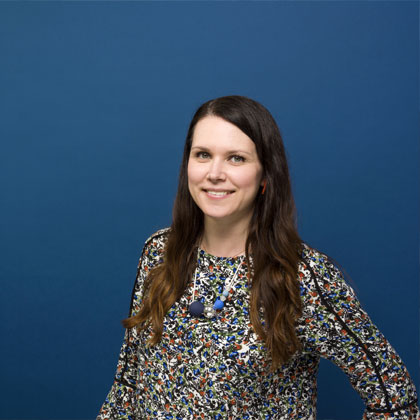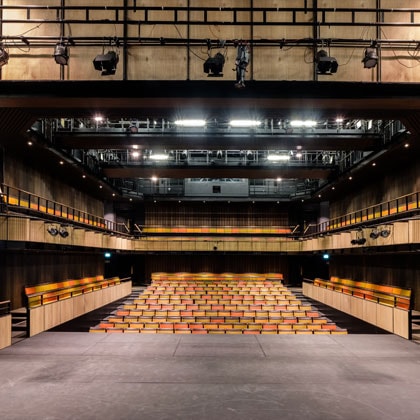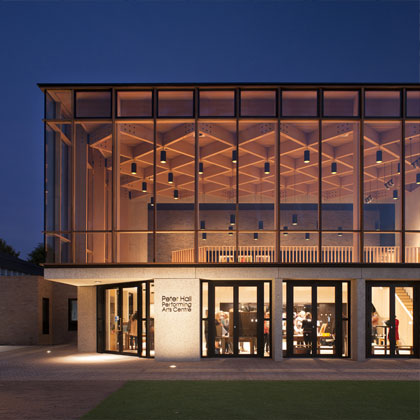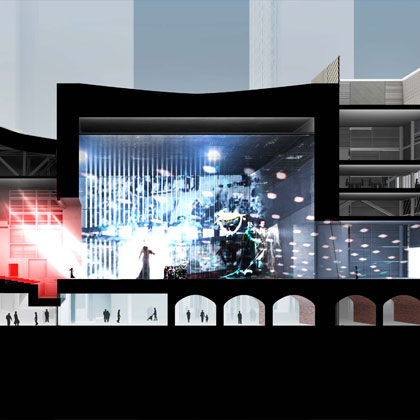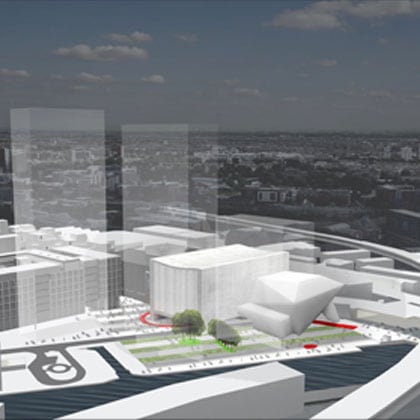
Having developed a fascination with stage lighting as a student in the UK, Jenni Harris pursued a career in theater, gaining experience in the ‘business’ end of theater management as well as the technologies and practicalities of technical production. As a busy touring technician, production manager and associate lighting designer, Jenni has witnessed the good and bad of venue design and now contributes her valuable experience to the collaborative powerhouse of multi-award-winning theater consultancy, Charcoalblue . . .
How did you first become involved with performance technology?
I was studying for a BA (Hons) in Drama & Theatre Arts at Staffordshire University back in 2000 when we were suddenly given a Technical Tutor and told we’d be creating and operating all the technical elements to our productions, as well as performing. This was music to my ears as I had already slowly started to realize that being on stage wasn’t for me - but I had found myself becoming fascinated with the history and theory of light and lighting for the stage, and the crucial impact it can have on a performance. That was it for me, after that I was fixated - one could say ‘focused’ - on carving out a career in theater production lighting.
What was your route to becoming a performance technology consultant?
A convoluted one! After my degree, I still wasn’t quite sure about a route into lighting from the degree I had been studying. I went on to complete a Master’s Degree at Chester University in the Theory of Performance, where I applied theoretical notions to my own devised work. This required designing and implementing all the technical aspects to support a production.
From there I found myself living in Manchester whilst working for the Palace Theatre & Opera House in their sales and marketing team. My three years spent there were invaluable in learning all about the ‘business’ side of theater; working with producers, marketing a show, operating a theater, sales and revenue - but my passion for lighting was still dimly glowing in the background!
In 2008 I made the decision to return to education and retrain in technical production skills at Guildford School of Acting – that was the most intense period of learning I had ever encountered and definitely readied me for the life of a technician.
When I graduated, I was given my first professional job by the lovely and very talented Lighting Designer Richard G. Jones as his Associate on The Hot Mikado, directed by Craig Revel Horwood at The Watermill Theatre in Newbury, followed swiftly by a brief stint on The Railway Children at Waterloo and then back to The Watermill for Copacabana.
I landed my first tour, as the Technical Manager and Relighter, with Northern Broadsides’ touring production of The Canterbury Tales. In 2013, after a number of years touring around the UK, I was working on a touring production at the Rose Theatre, Kingston, when I received a call from Paul Franklin at Charcoalblue asking if I’d ever considered a career in consultancy – and the rest, you could say, is history!
How long have you been doing what you do?
I’ve been with Charcoalblue for over seven years now, but have been doing all things ‘lighting’ for around 20 years.
If you hadn’t become a consultant, what do you think you’d be doing instead?
Gosh, I hate to think! I’d probably still be touring, living out of a suitcase. I was veering more into Production Management when I stopped touring, so perhaps something more along those lines? But definitely still in the world of theater. I guess we’ll never know!
If someone asks you what you do for a living, how do you describe it?
Depends who’s asking! But, generally, I say I work for a company that designs theaters; we sit on the design team with the architect, structural engineer, M&E engineer etc. and consult on all things theater, be that technical systems, acoustics or digital design or perhaps a turnkey service.
Can you outline the variety of the projects you undertake?
Anything and everything – that’s part of our company ethos, no job is too small or too big, ‘theater’ can be made anywhere. We work on historic theaters through to contemporary workplace and from permanent buildings to temporary structures.
What do you most enjoy about the process of your work?
As a company, we won’t dictate to you – our approach is based on collaboration, capitalizing on our shared experiences and developing user-led projects that meet the clients’ needs, rather than imposing a pre-defined solution. We have a strong commitment to theatricality and innovation, and to taking advantage of new techniques and materials.
What are the most challenging aspects of your work?
Budgets, storage and loos!
What would you say are the key elements required for a successful project?
A great performance space should not only perfect the basics but allow a creative team to innovate. That’s our challenge as consultants – to use our pooled knowledge to create inspiring, dynamic and pioneering spaces where visions can be realized.
What are the key skills or attributes that you require to do your job well?
At Charcoalblue, we believe that amazing work is built on true collaborative relationships, a huge amount of passion and a curious mind. We are passionate about finding creative solutions for our clients and we believe strongly that our unique theatrical innovation approach translates into all our projects.
What are the most common misconceptions that you encounter among clients?
The two biggies - that we only work on theaters and that we only offer acoustic design services for auditoriums, meaning we can’t design the acoustics for the rest of the building – both wholly untrue.
Which piece of advice do you give to clients most often?
You know your building best, you tell us and we will listen – and if you don’t, let’s get out and see some precedent venues and work together to design a building fit for purpose, that you’ll love.
What is the most frustrating aspect of your job?
Not being able to work in the venues we’ve designed! We’ve all spent years touring into venues that just don’t work, which is what drives a lot of us as individuals and our designs, to ensure the buildings of the future ‘just work’ for the end users.
Can you tell us something about being a consultant that most people don’t realize?
We work just as long hours as we did when we worked as creatives in theater!
Which of your projects have you found most satisfying, and why?
The ones where I have a personal connection – The Peter Hall Performing Arts Centre at The Perse School in Cambridge, was the first project which I led for Charcoalblue from start to finish. I was Team Leader, Stagelighting & Audiovisual Designer (they like to keep me busy!) so I was invested in the project. I knew the building and the systems inside out. We had a fantastic client, with vision and aspirations, and the design team was a dream – it was just a magical combination and I think that shows in the finished design – the building has gone on to win numerous awards, for which I’m immensely proud.
Another project I lead for Charcoalblue is The Factory in Manchester. I also led the early stages of the Stage Lighting systems design. Having lived and worked in the city for several of my formative years, I jumped at the chance of being able to ‘give back’ to Manchester, which is so rich and diverse in its arts and culture. The Manchester International Festival are an amazing company and their work is phenomenal. I can’t wait for opening night!
But actually, I find all of them both rewarding and satisfying – to know that I’ve contributed toward a fantastic building, which is going to be loved and well-used for many years to come, is the best feeling.
How do you keep yourself appraised of new technology and potential solutions?
Going to see as many shows as possible – if you can’t work out how they’ve done something technically then you know it’s good, and I want to know how they’ve done it!
Making sure we maintain relationships with clients is key, as is our rapport with manufacturers and being kept up-to-date with their product development.
How has clients’ awareness of LED lighting technology changed in recent years?
Now that LED is more widely used it’s a concept that’s more easily explained and demonstrated to clients – there are numerous examples of large to smaller applications that we can take them to see.
We’ve also found that as it’s been more widely accepted by designers, generally, it’s been more accepted by theaters.
Some clients drive the LED route from day one and already understand what that means from a cost perspective – which is great when it comes to discussing budgets and capital spend.
What are the biggest changes you’ve witnessed in equipment & system specifications in recent years?
I was having this discussion with my colleague Graeme McGinty only the other day, and we agreed that more recently people are generally savvier with networks, nodes etc. The whole concept of networking is universally accepted as a theater technicians’ tool rather than being seen purely as an IT tool nowadays. The use of Art-Net, sACN etc. are much more commonplace; the lighting desk is essentially a PC so people are much more willing to engage with network connectivity than they once were.
People embrace digital technology now rather than shying away; it’s just as easy to use digital audio as it is analogue audio.
Ergonomics is another big one, products being designed more with the end user in mind – only recently we’ve seen the new Stage Manager’s desk designed in collaboration with the SMA.
How important is it for you to have a close working relationship with the equipment manufacturer’s representatives?
Imperative. I think we keep each other abreast of everything and that’s how we all keep up! It’s great to be involved in early design discussions around products, which are still in their infancy. Being a part of that design process, being able to feedback on what has and hasn’t worked so well in past applications, is invaluable to the products that are then available to us, as consultants, to specify.
Solutions-wise, what is missing in the marketplace? What would you most like to see from manufacturers?
From a lighting perspective, it is still the core things, such as making the kit quiet, as we know from having our own in-house acousticians, this can make or break the experience of a room. The other one of note would be the consistency of light output, I think there’s still work to be done in this area.
